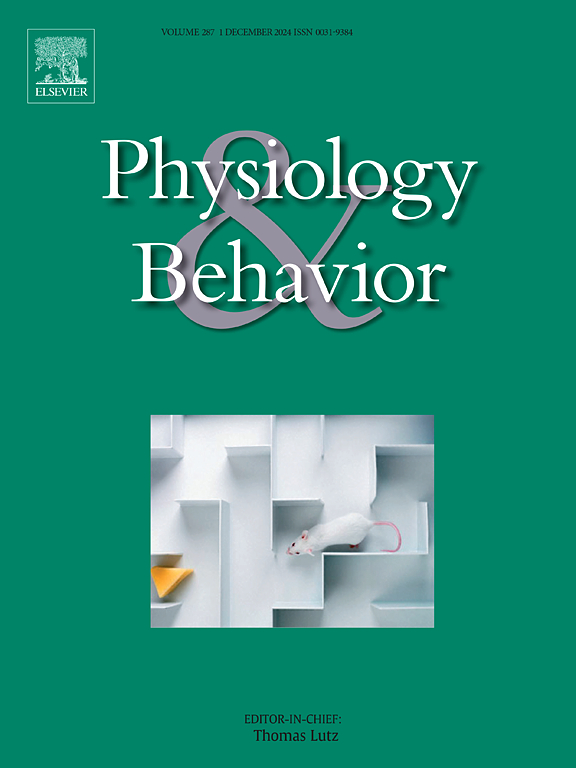Impact of satiety on palatable food associative learning and consumption in male and female adult rats
IF 2.5
3区 医学
Q2 BEHAVIORAL SCIENCES
引用次数: 0
Abstract
Hedonic and memory mechanisms can stimulate food cravings and consumption in sated individuals, promoting binge eating and obesity. Despite that, how satiety impacts learning and memory about cues for palatable food in males and females remains unclear. This is the first study to directly compare food associative learning, extinction, and memory renewal between hungry and sated subjects of both sexes. Food-restricted and sated male and female adult Sprague Dawley rats were trained in Pavlovian cue-food conditioning sessions, followed by cue-only presentations during extinction in a different context. They were then tested for renewal of conditioned responding to the food cue by return to the conditioning context. Conditioned responding was assessed through foodcup approach behavior. These rats were also tested for consumption of palatable food and chow before and after the learning and memory protocol. Sated rats demonstrated learning, extinction, and renewal of conditioned responding, indicating that physiological hunger is not required for learning and memory of palatable food cues. There were differences during cue-food acquisition, food-deprived rats learned faster and reached a plateau in conditioned responding sooner than sated rats. However, there were no differences after the fourth session, when sated rats reached the same level of responding as the food-deprived rats. There were sex differences during early acquisition under sated but not hungry states. Sated females had higher conditioned responding than sated males, while food-deprived rats of both sexes responded similarly. Extinction and renewal tests showed that both hungry and sated rats successfully decreased and subsequently renewed their conditioned responses. These results demonstrate the durability of learning and persistence of food-cue memory regardless of hunger state. Consumption tests found that all rats prefer palatable food compared to chow. Females, particularly when sated, consumed more palatable food compared to males. Higher palatable food consumption and learning in females suggest an enhanced sensitivity to palatable rewards. Correlation analyses found a positive relation between the amounts of food rats consumed and their conditioned responding in both sexes. These results demonstrate robust associative learning and memory under satiety and add evidence of sex differences in hedonic food motivation.
饱腹感对雌雄成年大鼠可口食物联想学习和消费的影响。
享乐和记忆机制可以刺激饱腹者对食物的渴望和消费,促进暴饮暴食和肥胖。尽管如此,饱腹感如何影响男性和女性对美味食物线索的学习和记忆仍不清楚。这是第一个直接比较饥饿和饱腹两性受试者之间食物联想学习、消失和记忆更新的研究。研究人员用巴甫洛夫的线索-食物条件反射训练了食物受限和饱食的雄性和雌性成年斯普拉格·道利大鼠,然后在不同的环境中进行了灭绝期间只有线索的展示。然后,通过返回条件反射环境,测试他们对食物线索的条件反射的更新。条件反应通过食物杯接近行为进行评估。在学习和记忆方案前后,这些大鼠还接受了美味食物和食物的摄入测试。饱腹大鼠表现出条件反应的学习、消失和更新,表明生理饥饿不是学习和记忆美味食物线索所必需的。在线索食物获取方面存在差异,缺食大鼠比饱食大鼠学习更快,条件反应更快达到平台期。然而,在第四次实验之后,当吃饱的大鼠达到与没有食物的大鼠相同的反应水平时,没有任何差异。在饱足而非饥饿的早期习得状态下存在性别差异。饱食的雌性比饱食的雄性有更高的条件反应,而被剥夺食物的雌雄老鼠的反应相似。灭绝和更新测试表明,饥饿和饱食的大鼠都成功地减少并随后更新了它们的条件反应。这些结果证明了学习的持久性和食物线索记忆的持久性与饥饿状态无关。消耗测试发现,与食物相比,所有的老鼠都更喜欢美味的食物。与男性相比,女性,尤其是在饱的时候,会摄入更多美味的食物。女性对美味食物的摄入量和学习能力越高,表明她们对美味奖励的敏感度越高。相关分析发现,无论男女,大鼠摄入的食物量和它们的条件反应之间都存在正相关。这些结果表明,在饱腹状态下,联想学习和记忆是稳健的,并为享乐性食物动机的性别差异提供了证据。
本文章由计算机程序翻译,如有差异,请以英文原文为准。
求助全文
约1分钟内获得全文
求助全文
来源期刊

Physiology & Behavior
医学-行为科学
CiteScore
5.70
自引率
3.40%
发文量
274
审稿时长
47 days
期刊介绍:
Physiology & Behavior is aimed at the causal physiological mechanisms of behavior and its modulation by environmental factors. The journal invites original reports in the broad area of behavioral and cognitive neuroscience, in which at least one variable is physiological and the primary emphasis and theoretical context are behavioral. The range of subjects includes behavioral neuroendocrinology, psychoneuroimmunology, learning and memory, ingestion, social behavior, and studies related to the mechanisms of psychopathology. Contemporary reviews and theoretical articles are welcomed and the Editors invite such proposals from interested authors.
 求助内容:
求助内容: 应助结果提醒方式:
应助结果提醒方式:


